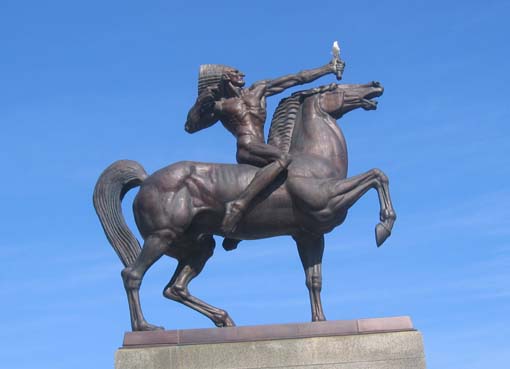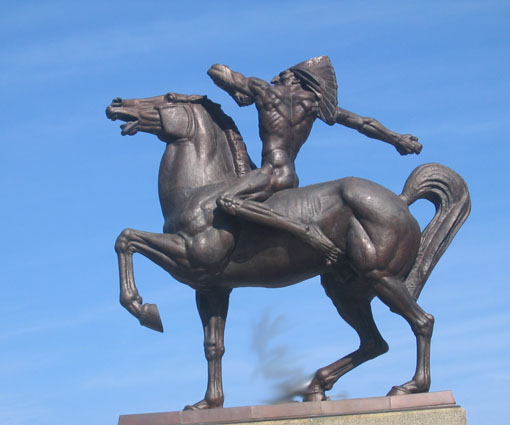
Sponsored Ads
|
» Home
» People » Ivan Mestrovic's The Descent from the Cross sold for 250 000 EU at Sotheby's
» Home
» Culture And Arts » Ivan Mestrovic's The Descent from the Cross sold for 250 000 EU at Sotheby's
| Ivan Mestrovic's The Descent from the Cross sold for 250 000 EU at Sotheby's |
| By Dr. Mate Meštrović |
Published
11/12/2008
|
People , Culture And Arts
|
Unrated
|
|
|
|
Mestrovic is the author of Chicago Indians prepared in Zagreb
Ivan Meštrović (1883-1962), outstanding Croatian sculptor
Ivan Meštrović: The Descent from the Cross (1913)
Sotheby's u Londonu danas je najznamenitije aukcijsko poduzeće u svijetu. Nedavno je tamo prodan drveni reljef Ivana Meštrovića The Descent from the Cross iz 1913. (90 x 126 cm) za više od 250 000 EU (205,250 GBP), što je izniman uspjeh osobito s obzirom na sadašnji pad cijena na svjetskom tržištu umjetnina.
Krajnja prodajna cijena nadmašila je osam puta prvotnu minimalnu procjenu za The Descen from the Cross. Na dražbi 19th and 20th Century European Sculpture ponuđena su 110 djela, a prodana su 50. Konačna prodaja (Sale Total) svega iznosi 1.000.000 GBP, od kojih čak jedna petina predstavlja cijena najskuplje prodanog djela na toj aukciji - Meštrovićevog reljefa iz 1913.
Ivan Meštrović tako ostaje i dalje u svijetu najtraženiji umjetnik (naročito kipar) s ovih prostora , a vrijednost njegovih djela se sve više prepoznaje. Dana 29. svibnja 2008. kuća Sotheby's prodala je i Meštrovićev portret Ruze Klein iz 1915 za 90,500 GBP.
Mate Meštrović
|
Sotheby's is London today the most famous auction company in the world. Recently Ivan Meštrović's wooden relief The Descent from the Cross from 1913 (90 x 126 cm) has been sold there for more than 250,000 EU (205,250 GBP), which is outstanding success taking into account the current decrease of prices on the world trade of works of arts.
The final price surpassed eight times the initial minimal bid for The Descent from the Cross. The auction 19th and 20th Century European Sculpture, included 110 works of art being bidden, and 50 of them had been sold. The Sale Total was 1,000,000 GBP, and Meštrović's relief from 1913 was the most expensive item, sold for no less than one fifth of the Sale Total.
Ivan Meštrović thus still remains the most wanted artist (especially among sculptors) from this part of eastern Europe, and the praise of his works of art is more and more recognized. In May 29th 2008 Meštrović's portrait of Ruža Klein from 1915 was sold by Sotheby's for 90,500 GBP.
Mate Meštrović
|
The important Descent from the Cross (carved in 1913 ) by Ivan Mestrovic, was exhibited at the unprecedented one-man show at the Victoria and Albert Museum in 1915.
The Victoria and Albert exhibition, the first honouring a living artist, was a testament to Mestrovic's artistic importance as well as to the political interests which he represented as a member of the Yugoslav Committee. The artist-patriot was instrumental in the setting up of Yugoslavia after the First World War, a project which he had come to London to work on during his years of exile from his native Croatia. The Victoria and Albert exhibition was opened by Lord Robert Cecil, assistant minister for Foreign Affairs.
The Descent had previously been shown in 1914 at the last Venice Biennale before the outbreak of the First World War - the label survives on the reverse. It attracted the critical attention of Ettore Cozzani who responded to the immediacy of the wood carving writing that 'one can feel the mashing and snapping of the fibres under the sharp steel blade.' Cozzani was the first to recognise the significance of the relief in the context of the war, a recognition which Charles Aitken, director of the Tate gallery, repeated in 1915 when he wrote that 'the mother of Christ resents His death as that of a warrior fallen in a just cause.'
This significance was not lost on Mrs Evelyn St George who purchased the relief directly from the artist in 1915 for L600 - the highest price Mestrovic had then achieved in England. Mrs St George, an American heiress and the companion of the painter William Orpen, met the Croatian sculptor through her friend Lady Cunard. Despite his bare grasp of English Mestrovic was a highly
sought-after addition to the soirées of London society's most influential hostesses. The relief had a particular resonance for Mrs St George. Her immense wealth and luxurious lifestyle had been no protection against the personal consequences of a world war: the tragic loss of her son, Avenel, in 1914 at the First Battle of Ypres. The relief was the first of the memorials Mrs St George would make for her son. She also financed the St George ward of the military hospital at Oldway House, near Paignton in Devon and commissioned a stained glass window for the reconstructed church of Zillebeke near Ypres.
The Descent was one of the first of a series of religious images which Mestrovic continued to carve throughout the war years. His friend the painter Jozo Kljakovic later recalled that 'he did little
else during the war except these details from the life of Christ. So deeply did the war shake him.' These works, mostly carved in wood relief, included the imposing Crucifix of 1919, as well as
reliefs of The Deposition, The Temptation and Christ and Mary Magdalen, some of which were destined for Mestrovic's chapel at Kastelet, near Split. Mestrovic said directly that pondering the war and the need for a European unity 'brought me to biblical themes.' The destruction and chaos of the war had left the artist disenchanted with political rationalisations and he turned to a different source of inspiration:
'The real guide is faith... when we try to find total harmony in what we call justice, truth, beauty, wisdom, divided like this they glimmer like fireflies and are gone.'
The Deposition is typical of the intuitive fervour of Mestrovic's religious works. The strong linear quality and flattened forms are reminiscent of the Byzantine icons which inspired him in Orthodox
Serbia. The figures are cramped and crowded into an acute pitch of emotional intensity. Distress is articulated in gestures and expressions closely juxtaposed, with the faces of Christ and his mother mirrored in a poignant motif. The carving itself has a particular material integrity as a knot in the wood is utilised in the place of the wound in Christ's side. The exceptional quality of the
relief drew praise from critics in both Venice and London with one London critic, Robert Ross calling it 'one of the finest things in the exhibition.' A later version of the relief is in the collection of the Tate Gallery, London .
Submitted by Mate Meštrović
|   Ivan Meštrović: Chicago Indians. Photos by Mr Vedran Nazor, New York. Meštrović prepared this monument in two years in his atelier in Zagreb, capital of Croatia, from 1926 to 1928. Then it was transported by the American ship "President Wilson" to the USA. Each monument has 8 tons and is about 6 meters high.
Please, do not miss the following deep thoughts of Ivan Mestrovic, as if written today (taken from the Zeljko Skropanic web site, unfortunately not extant any more): There are more and more people today who have come to the conviction that one of the main causes of the tragic events of the recent past, as well as those which loom on the horizon, is the fact that modern man has all but forgotten the great teachings of the Sermon on the Mount [The Bible, Mathew 5-7]. The blame for this rests not only on our contemporary despotism, but, unfortunately, on a long list of talented men of science and art who have not foreseen the corroding complications and destructive consequences of their doctrines. This atmosphere of unbelief, this tragic state of man cut off from the very axis which holds and moves everything, has had repercussions on all domains of human activity, including that of art, which in the most significant periods of civilization worked hand in hand with religion - an ennobling and spiritualizing factor in human life. Christian civilization, in our days, finds itself locked in a mortal struggle with the forces of secularism in varying forms and degrees. Many people fail to realize that Christianity, by waging the fight for its principles, defends also the foundation of the democratic way of life; for the concept of the dignity of each man and the equality of all men stands and falls with the Christian view that man is created in the image of God. Thus the Church is in the front lines of the battle against the onslaughts on human freedom. A moment ago, I mentioned my wood carving of the scene of the Crucifixion. The piece of wood on which I carved the Crucifixion has an interesting story which I would like to share with you. I was in Geneva, Switzerland, when I was seized by the desire to carve the Crucifixion. Every available oak had been bought by the factory that manufactured rifle buts, presumably for both warring sides. I had a hard time to acquire from the factory a few boards for relief. I was unable to get the whole piece of the trunk because they had all been sawed up. Finally, I discovered one trunk that had not been sawed off; it was withered and had stood with its roots in the soil and was not considered good for rifles because it was assumed that the wood was probably decayed. When I started to work on it, I discovered that it was solid and whole. The lumberman told me that it had been imported. I was surprised to learn that it had come from Croatia, my native country. That same piece of wood was later returned to Croatia, transformed into the Crucifixion scene. Today it stands there, in a small Chapel, in the country where the Catholic Church is being crucified daily. The head of that suffering Church is Cardinal Stepinac, my compatriot, my dear friend, of whom I and all Croats are proud. I am sure that our feelings are shared not only by all the Catholics throughout the world but also by all men of goodwill everywhere who cherish freedom of spirit In vain do the Godless and restless men, who are today making weapons in the hope of enslaving the world, think that the trunk of the Christian tree is withered. It will outlive and outlast the forces of evil in my native land and throughout the whole world. He who has conquered death will conquer the destruction of His teaching. Source www.croatianhistory.net
|
Formated for CROWN by prof.dr. Darko Žubrinić
Distributed by www.Croatia.org . This message is intended for Croatian Associations/Institutions and their Friends in Croatia and in the World. The opinions/articles expressed on this list do not reflect personal opinions of the moderator. If the reader of this message is not the intended recipient, please delete or destroy all copies of this communication and please, let us know! |
Related Articles
Related Links
|
|